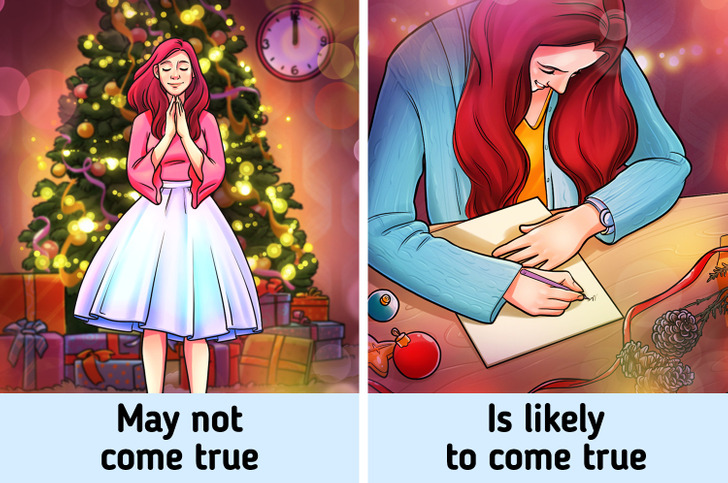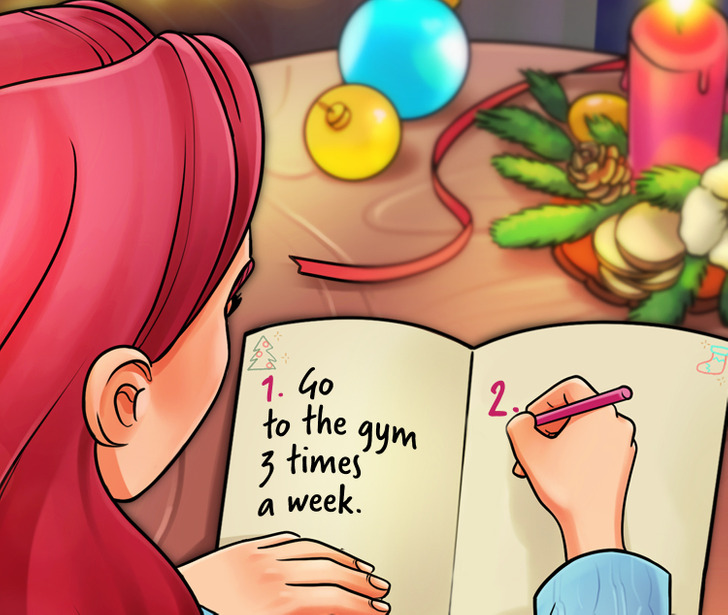How to Make Your New Year’s Wishes Come True

On New Year’s Eve, we all become children for a moment and want to believe that our wishes will certainly come true. Running a marathon, learning French or Chinese, becoming healthier and happier, meeting our true love, or starting life from scratch — at this moment, all sorts of goals and dreams rush through our heads. But have any of last year’s wishes come true?
5-Minute Crafts asked psychologists to find out what techniques can make our New Year’s wishes (and beyond) come true.
1. Define your wish.

The time the clock strikes midnight is usually too quick for you to understand your true desires and how to make them come true. Sometimes our “wants” just flicker in our heads, but it’s difficult to remember them and, therefore, bring them to life.
Gabriele Oettingen, a professor of psychology at New York University, suggests this way of determining your deepest desires:
- Take 5 to 10 minutes of quiet time to ask yourself one question: “What do I really want?” Find a desire that is dear to your heart in whatever area of life it may lie. The main thing is to ask this question and find the true answer. Often, people don’t know what they want or are told what they want. Remember that you are the main expert in your life. You have your own needs and dreams.
- Psychologists also recommend writing down your goals, New Year’s plans, and wishes. “If you write down goals, you’re 42% more likely to achieve them,” says psychology professor Dr. Gail Matthews at the Dominican University in California.
2. Visualize the result.

3. Think of the obstacles standing between you and your dream.

Gabriele Oettingen and her colleagues have found that the imagery we visualize in our mind may slow down the realization of our wishes. For example, you may have wanted to have your book published for a long time. When you imagine yourself holding the bestseller and accepting an award for your literary success, you experience success and achieve your goal in your mind. This can have a relaxing effect. As a result, we put forth less energy and effort that is required to make your wishes a reality.
Thanks to this discovery of scientists, a tool called WOOP appeared. It stands for “wish, outcome, obstacle, plan.” We’ve already described the first 2 elements of this tool (making a wish and the visualization of the result) above. By thinking over the obstacles you’ll have to face on the way to your wish, a connection is established, linking the desired future with reality.
Think about the obstacles standing in the way of realizing your wish. This can be not only external reasons but also internal resistance (for example, fear of change or a feeling of guilt toward loved ones for spending time on achieving your personal goals). It’s important to uncover the belief, behavior, or emotion that’s holding you back.
4. Develop a plan.

- Identify how you can overcome the obstacles.
- Break down your big wish into smaller goals and add specific steps for each goal.
- Describe each step you’ll take to achieve your goal in detail. For example, you want to become healthier in the coming year. If you leave your wish too vague by writing down something like, “to take care of my health better,” it’s unlikely to happen. But if you know what steps to take from this moment on (for example, eating healthy food, doing yoga in the morning or after work, eating 1 piece of cake instead of 2), you have more chances to achieve it.
- Decide what other steps you need to take to make your wish come true. Maybe you need to start jogging in the morning or go to the gym. Determine clearly what gym it should be, how many times a week you’ll go there, and so on.
- Formulate your steps in positive terms. That is, focus on the action you are about to take, not on the activities that you want to avoid.
New Year’s wishes should not go unfulfilled. Using this science-based strategy, you will make your dreams come true.